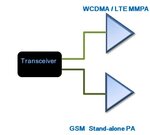criterion456
Member level 2
Hi, from the following link :
https://datasheet.octopart.com/SKY77629-13-Skyworks-Solutions-datasheet-16052582.pdf
A MMPA (MultiMode MultiBand Power Amplifier) can cover GSM / WCDMA / LTE
Nevertheless, some designs adopt a stand-alone PA for GSM. As the photo below :

The design increases cost and PCB placement area.
I don’t know what the benefit and consideration are.
My opinion is that WCDMA / LTE need APT(Avearage Power Tracking) or ET (Envelope Tracking), but GSM doesn’t. But I am not sure it is correct or not.
Would you please tell me the reason ??
Thanks a lot~!!
https://datasheet.octopart.com/SKY77629-13-Skyworks-Solutions-datasheet-16052582.pdf
A MMPA (MultiMode MultiBand Power Amplifier) can cover GSM / WCDMA / LTE
Nevertheless, some designs adopt a stand-alone PA for GSM. As the photo below :

The design increases cost and PCB placement area.
I don’t know what the benefit and consideration are.
My opinion is that WCDMA / LTE need APT(Avearage Power Tracking) or ET (Envelope Tracking), but GSM doesn’t. But I am not sure it is correct or not.
Would you please tell me the reason ??
Thanks a lot~!!